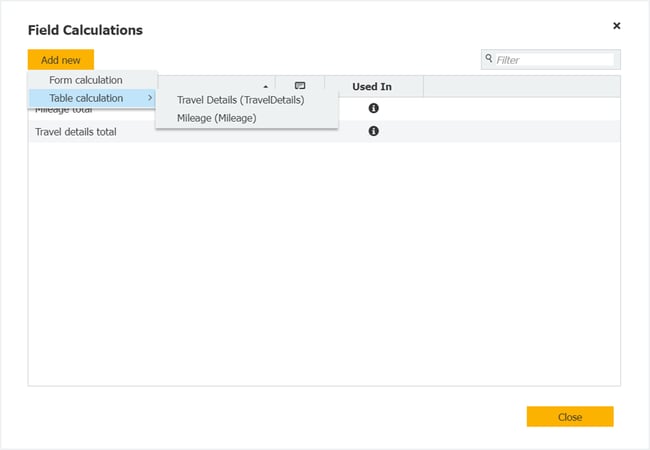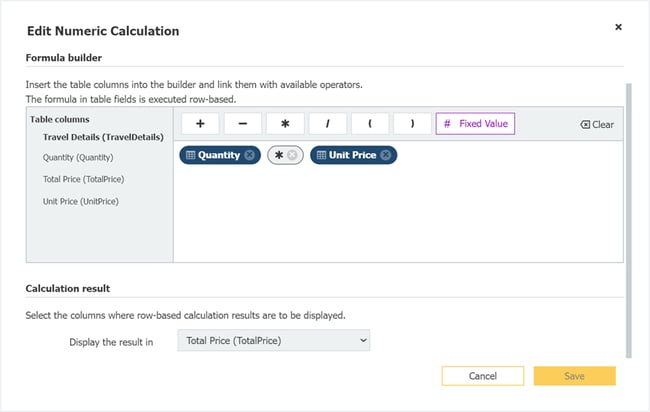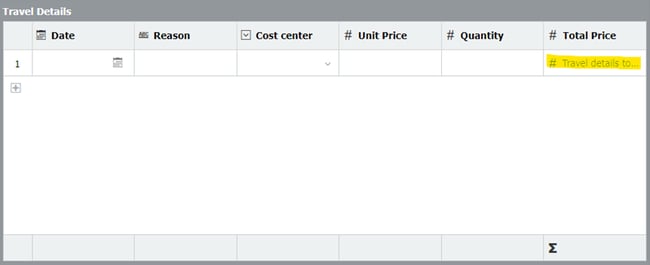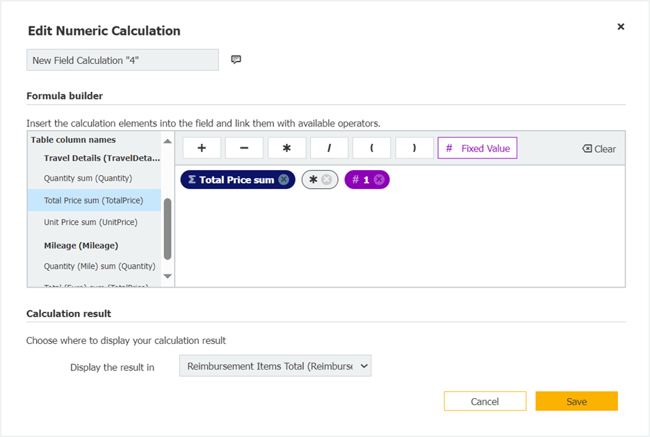With the new versatile table calculation features in DocuWare Forms, you can better meet your accounting needs to speed up processes. Find out what's possible by looking at the example of travel expense reports.
In DocuWare forms, it’s now possible to perform calculations between numeric columns within a table, to aggregate sums of columns across multiple tables, and to use other numeric fields on the form and fixed numbers to construct formulas.
Content:
Use Case Travel Expense Report
Get to know the new automatic calculation possibilities using the example of travel expense reports.

Travel expense form: All numbers in the highlighted fields are calculated automatically based on formulas
These are the calculations behind:
- Travel Details: For each item the colleague entered, the unit price is multiplied with the quantity to get each total price.
- Mileage: For each distance traveled, the reimbursement is calculated by multiplying the number of miles with a fixed rate, in this example 0,7 euro per mile.
- Reimbursement Items Total: For this field, the sum of the entries from column “Total Price” of the first table is generated.
- Mileage Total: The sum of the entries from column Total (Euro) of the second table is displayed in this field.
- Total to claim: Here you get the sum of the calculations 3 and 4.
The automatic calculations are beneficial for both the employee filling out the form and the accounting staff. The requestor directly gets the calculation results as information, for the accountants it saves valuable time and avoids the possibility of human error in calculations.
And since all calculated values can be used as index entries, they can also route the travel expense claim in the process. For example, if the total is more than 1 000 Euro, the claim is automatically routed not only to the manager for approval, but also to the appropriate person in the HR department.
Read also how travel expenses can be quickly tallied and reimbursed.
Here's how: Configurating the calculations
Table calculation
First, the calculation within a table will be needed. Start with creating a table with multiple number columns.

In the Field Calculations dialog, click "Add new," then choose "Table calculation," and select the specific table where you want to create your formula.

You can use table columns from the table and fixed values in these formulas. The calculation can only use elements from the same table and display the result in that table.

On the designer canvas, you will observe a placeholder denoting the name of the formula, serving as an indicator that this is where the formula's result will appear. On the published form, form fillers will not be able to interact with the result column.

Form Calculation
Calculation within a table is not enough to cover the travel expense report. You might need to index the sum of the column or use the value for some other purposes.
Once all essential table columns and numeric fields on the form have been set up, simply navigate to “Add New” > “Form Calculation” to access the Formula builder.

Within the formula builder interface, you'll find a whole list of numeric fields and numeric column sums as formula elements. Effortlessly arrange your formula by dragging and dropping these elements into the designated formula space. Remember to select a specific numeric field to display the calculation result; doing so will automatically configure the chosen numeric field as read-only.

This new extension will bring a lot of variety to your forms. As the above example shows, creating the formula: “Column Sum*1” should allow users to automatically present the sum of the column outside the table within a numeric field. This also significantly facilitates the indexing process meanwhile opens up the possibility of utilizing this value in other formulas.
The features listed here are already available in DocuWare Cloud and will be included in the upcoming DocuWare Version 7.10 for on-premises systems. More information about the version will be available here on the product blog at the end of April/beginning of May.


